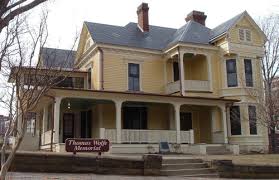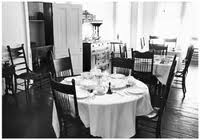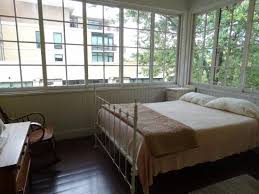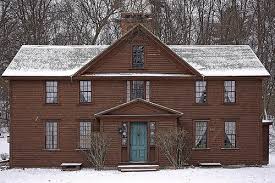YOU CAN GO HOME AGAIN: VISITING WRITERS’ HOMES

The boardinghouse where Julia Wolfe brought her young son, Thomas, Asheville, NC
6/4/16 – YOU CAN GO HOME AGAIN: VISITING WRITERS’ HOMES
Touring Thomas Wolfe’s childhood home in Asheville, NC recently, I saw, like many others before me, how his childhood translated into his novels. I also saw how growing up here had in many ways been perfect soil for a budding writer.
A kid separated from his siblings to grow up in a boardinghouse, share bedrooms with guests, and help his enterprising mama serve up stews would have plenty of material to ponder, and time to ponder it. Having a maverick but grief-stricken mother and the temper and passion of his father on hand didn’t hurt either. I wondered whether I might find equally conductive conditions in the childhood homes of other writers.
I’ve always been drawn to writers’ homes. Once I had a long layover in Frankfurt, and desire number one was to sail down the Rhine to see Goethe’s home. Whether I was so drawn to the home because I thought Goethe left some kind of genius in the walls that would rub off on me, or because I was curious about the relationship between place and person, I can’t say—but it mattered to me to be physically in a space in which he had lived and breathed.
For similar reasons, I made Anne Frank’s hide-out a top priority when in Amsterdam, Pablo Neruda’s quirky home a must in Valparaiso, and Louisa May Alcott’s childhood home a frequent drive-by when I lived near Concord, MA.
Tales from Childhood
My recent road trip involved touring not just of Wolfe’s home, but those other influential figures, including Andrew Jackson, Thomas Jefferson, and James Madison, all of whom were writers in a broader sense of the word. While the tour experiences varied in quality and even historical accuracy, I found that stepping into these physical worlds inevitably provided a more visceral sense of what might have inspired, and influenced, each person.
Only Wolfe’s home was a childhood home, though, one in which he had gone from little boy to man, and therefore one that it seemed might have influenced his character and proclivities in particular. Clearly many writers’ homes reflect the writer, but how many writers reflect their homes? Here it seemed that childhood homes were more likely to be the influencer, not the influenced.

Think of all the characters who boarded at the Woilfe home and dined here!
At age six, Thomas Clayton Wolfe, the youngest of eight children, was whisked two blocks away from the family home to live with his mother in her “Old Kentucky Home” boardinghouse. He would spend days with his older siblings, but it was only young Thomas and his mother who slept in the boardinghouse. That undoubtedly made the boy feel special but also gave him a chance to meet and observe a much larger world. It was easy to see how these walls and the experiences within them had shaped Wolfe as a novelist.
This is hardly news, of course. Everyone who has heard of Wolfe also knows that he only thinly disguised his childhood home life in his writing. His novels were so deeply biographical that for many years his neighbors, unhappy at their portrayal, vilified him. I did discover some intriguing ironies, including the fact that W.O. Gant, Thomas’s father, originally moved to Asheville to help treat the tuberculosis of his second of three wives, unknowingly fating his lastborn child Thomas to a death from that very same disease at the age of 37.

Did young Thomas Wolfe sneak out of a window here like Eugene Gant to court a young girl? Or did he just dream about it?
Beyond a few new insights, I also found that inhabiting the physical space itself reinforced and even refined my prior understanding of Wolfe and his writing. Walking through the set dining room tables, touring the various bedrooms, or peering into bookshelves, I grasped in a deeper and more precise way how a young “book brooder” looked homeward to become Eugene Gant. It also made me wonder whether or not other writers’ childhood homes were equally transparent or revealing.
Looking Backward
A quite perusal of my memory and the Internet quickly provided some fascinating facts about the childhood homes of other writers:

Orchard House, the childhood home of Louisa May Alcott, Concord, MA
Louisa May Alcott. The Orchard House is obviously central to Louisa May Alcott; it’s impossible to imagine Little Women without it. Alcott not only grew up here but wrote and set her novel in this very house, which had been purchased by her father, after his return from Fruitlands, a utopian transcendentalist commune he had co-founded. At Orchard House Lousia was surrounding by many of the leading writers, thinkers, and social reformers of her day including Ralph Waldo Emerson, Henry David Thoureau, and Nathaniel Hawthorne. With parents dedicated to cultivating their children and bettering the world, books and art and stimulating conversation all around, it is easy to see how this home produced a writer.
Edgar Allan Poe. I have no excuse for never visiting Poe’s house in Baltimore, but that is the sad truth, even though I’ve lived nearby for nearly 16 years. Not that it turns out to be a tremendous loss, since Poe lived in this house only three years in his early twenties. Poe’s childhood home is in Richmond, VA, and I missed it when I was there (or, rather, the Poe museum several blocks away from the actual house). Poe was the second of three children born in Boston to travelling actors, both of whom died before he was four. Like Wolfe he was also separated from his siblings, taken in by a wealthy tobacco merchant in Richmond who it seems raised him to be a genteel Virginia businessman. In spite of this home and this upbringing, something in Poe—the visceral memory of the actor parents, the early separation from the siblings, who knows?—made Lord Byron, not tobacco selling, his dream.
Anne Frank. Anne Frank’s House on the Prinsengract Canal with its secret annex is inexorably linked to the story she told about her family’s hiding place during the Holocaust in the diaries that made her famous. In this case, there is no question that the home and the circumstances were inexorably linked to the writer she became, although there are many indications in her prose that, had she not faced the circumstances, she may have turned her sensibilities to writing entirely different works, perhaps works not so traceable to her childhood home.

A childhood of art, nature, and illumination (literally) in Oak Park, IL for Ernest Hemingway
Ernest Hemingway. You can see the house where Hemingway was born and spent his first six years in upper middle class Oak Park, IL—although I have never done so, despite being a Chicago-area native. Built in 1890 for his mother’s parents, this handsome house with its wraparound porch, elegant parlor, and well-stocked library also happened to be close to nature preserves and trails, perhaps first sparking the love of nature so central to his later work. The house was the first in the entire town to have electricity, and here Ernest’s mother, an opera singer and composer, taught music students, initially from the elegant parlor and later from a dedicated music room. It is fairly easy to envision a child growing up in such circumstances and having something to say and the confidence to say it, even the glimmerings of a self-created mythological hero with the love of both nature and the arts. Still, he could just as easily have bought into the “wide lawns and narrow minds” mentality of so many of the others growing up around him.
No Rhyme or Reason
Looking backward is cheating. of course. While it’s easy to see how Orchard House produced Louisa May Alcott or the Old Kentucky Home produced Thomas Wolfe, it’s not so easy to know what these two, or any writer, would have done with a different childhood.
Equally clear from the few examples here is that there is no overarching formula for growing a writer (not that I thought I would find one!). While having a home well-stocked with books, ideas, and ambitious parents may have been critical to some writers, it was certainly no guarantee of any particular life course. In some cases having a keen eye or sensitivity was more central than the circumstance. Still, it’s fun to visit these homes and think about the ways these spaces and artifacts may have shaped the writers that have meant so much to the world, and I plan to continue to do so.
Cheers.
Terra Ziporyn
TERRA ZIPORYN is an award-winning novelist, playwright, and science writer whose numerous popular health and medical publications include The New Harvard Guide to Women’s Health, Nameless Diseases, and Alternative Medicine for Dummies. Her novels include Do Not Go Gentle, The Bliss of Solitude, and Time’s Fool, which in 2008 was awarded first prize for historical fiction by the Maryland Writers Association. Terra has participated in both the Bread Loaf Writers Conference and the Old Chatham Writers Conference and for many years was a member of Theatre Building Chicago’s Writers Workshop (New Tuners). A former associate editor of the Journal of the American Medical Association (JAMA), she has a PhD in the history of science and medicine from the University of Chicago and a BA in both history and biology from Yale University, where she also studied playwriting with Ted Tally. Her latest novel, Permanent Makeup, is available in paperback and as a Kindle Select Book.
- Web |
- More Posts(106)